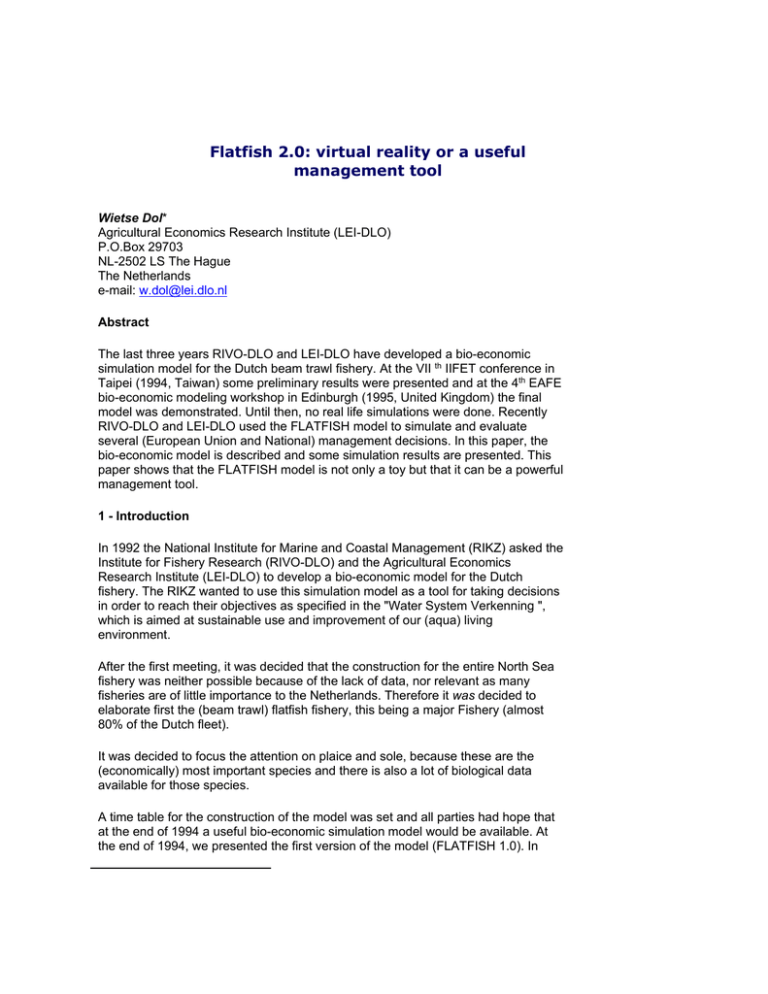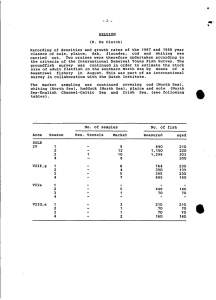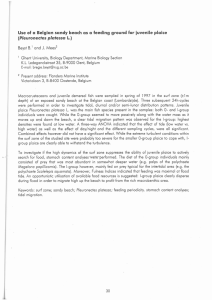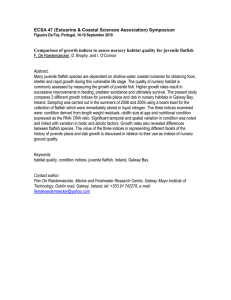Flatfish 2.0: virtual reality or a useful management tool
advertisement

Flatfish 2.0: virtual reality or a useful management tool Wietse Dol* Agricultural Economics Research Institute (LEI-DLO) P.O.Box 29703 NL-2502 LS The Hague The Netherlands e-mail: w.dol@lei.dlo.nl Abstract The last three years RIVO-DLO and LEI-DLO have developed a bio-economic simulation model for the Dutch beam trawl fishery. At the VII th IIFET conference in Taipei (1994, Taiwan) some preliminary results were presented and at the 4th EAFE bio-economic modeling workshop in Edinburgh (1995, United Kingdom) the final model was demonstrated. Until then, no real life simulations were done. Recently RIVO-DLO and LEI-DLO used the FLATFISH model to simulate and evaluate several (European Union and National) management decisions. In this paper, the bio-economic model is described and some simulation results are presented. This paper shows that the FLATFISH model is not only a toy but that it can be a powerful management tool. 1 - Introduction In 1992 the National Institute for Marine and Coastal Management (RIKZ) asked the Institute for Fishery Research (RIVO-DLO) and the Agricultural Economics Research Institute (LEI-DLO) to develop a bio-economic model for the Dutch fishery. The RIKZ wanted to use this simulation model as a tool for taking decisions in order to reach their objectives as specified in the "Water System Verkenning ", which is aimed at sustainable use and improvement of our (aqua) living environment. After the first meeting, it was decided that the construction for the entire North Sea fishery was neither possible because of the lack of data, nor relevant as many fisheries are of little importance to the Netherlands. Therefore it was decided to elaborate first the (beam trawl) flatfish fishery, this being a major Fishery (almost 80% of the Dutch fleet). It was decided to focus the attention on plaice and sole, because these are the (economically) most important species and there is also a lot of biological data available for those species. A time table for the construction of the model was set and all parties had hope that at the end of 1994 a useful bio-economic simulation model would be available. At the end of 1994, we presented the first version of the model (FLATFISH 1.0). In March 1995, there was a workshop on the flatfish model and the final version of the model was presented (FLATFISH 2.0a). The first policy questions were fed to the model and the first results were discussed. At the beginning of 1996, RIKZ asked RIVO-DLO and LEI-DLO to do some simulation studies. These studies are used as scenarios for the final report of the "Water System Verkenning", Due to the specific questions, a lot of new features were added to model (e.g. stochastic recruitment and the possibility to redistribute effort after closing an area). The current version of the model is FLATFISH 2.0d but improvements are made whenever possible/necessary. This paper will present some of the simulation studies. In the next section, the model is discussed and in section 3, some questions that could be answered with the model are summarized. This paper will discuss three simulation studies: 1. 2. 3. 30% effort reduction of the 1995 beam trawl fleet 2. economic and biologic effect of the Plaice Box 3. finding an economic optimum for the Dutch beam trawl fishery . This paper will end by presenting some conclusion and remarks. 2 -The model The bio-economic model used is quite similar to the one proposes by Rodgers (1992) and the economic part is fully described by Dol (1995). A diagram of the model is presented in Figure 1. Due to data limitations and time restrictions, the FLATFISH model, as described below, doesn't incorporate the processing industry. The model has two purposes. First, the model will be used to get a better insight in how biologic and economic aspects are related to each other. This model makes it possible to change biologic as well as economic parameters (simulating certain events) and then see what the consequences will be for the Dutch fishery and the fish stocks. Secondly, it will be used as a decision support tool to take decisions and select tools to reach certain specified (policy) objectives. It will be a model that can simulate the biologic aspects as well as the economic consequences of fishery and regulations. To be able to simulate currently popular and proposed policy measures, FLATFISH is a spatial model. For instance, effort and landings are calculated for every ICES rectangle of the North Sea. Since Dutch beam trawling is done on a weekly basis (fishermen leave on Monday and come back on Thursday/Friday). Several components are calculated every week. Data availability and the reduction of the size of the model is often the reason why other than weekly time steps are used. As economic units we have divided the fleet into six Horse Power groups. For those HP-groups the fish revenue and six costs components are calculated. Plaice is divided into six length groups and the sole into seven. These length groups are translated into market size categories. Figure 1: Flow-diagram of the economic part of the Flatfish 2.0 model 3 -Simulation possibilities This section will briefly discuss example of questions that can answered by the FLATFISH model. FLATFISH is not simple to use. To become more user-friendly, a simulation shell called FLATMAN (FLATFISH manager) has been developed. With this shell the most frequently asked questions can be simulated quite easily. However, before running the model we should have a clear vision what parameters and tables are necessary to run the simulation. We strongly advise that a team of biologist, economists, fishermen, and policy makers discuss what they want, discuss the assumptions that have to be made, then translate it into the model, run the simulation (and perhaps many others) and spend time comprehend all the output. After this, a discussion should take place, whether the outcome of the model is usable. This means that the model itself is only a tool that lets biologist, economists, and policy makers discuss and solve problems. The shell FLATMAN has a lot of possibilities to simulate the interaction between biology, (socio-) economy, and policy decisions, e.g. TAC's and Quota: for plaice, sole and the EU as well as the Netherlands Closed areas/seasons: per ICES rectangle, per HP-group and per month Mesh size, technical adjustments etc.: per HP-group a multiplier Technical improvement: per HP-group a multiplier Adjustment of the fleet: by age, by size etc. Days-at-sea: per week, per HP-group Prices for plaice and sole: ail market categories separately Fuel prices; a multiplier for the whole fleet Recruitment: for plaice and sole, per year, fixed or stochastic Growth: per length category per month/quarter The following sections will discuss the output and conclusions of three simulations. One should not forget that the results presented are only a sample of all the output that is generated. Before drawing conclusions you should spend a lot of time looking at all the results. 4 -Example 1: 30% effort réduction At the beginning of this year, the quota for plaice and sole were reduced by 40% respectively 25%. The underlying idea is that the reduction of the quota should result in a reduction of the fishing effort (and hence the fishing mortality) by 30%. This should result into a better/saver spawning stock biomass. The FLATFISH model can be used to simulate what would happen if no effort reduction would take place (i.e. the effort of 1995 will be the same for 1996-2015) and what would happen if the 30% effort reduction is realized. Biologist have put the MBAL for plaice at 300,000 tones and 35,000 tones for sole. Since the level of recruitment is determining the outcome of the FLATFISH model it is possible to calculate simulation runs with stochastic recruitment (i.e. the recruitment is a random sample from a log normal distribution). When looking at the figures of the next three simulation examples, you will see for every scenario three lines. These lines are the 5% median, and 95% lines. For every scenario we did 100 runs with stochastic recruitment and e.g. with the 5% line we mean that only 5% of the simulations bad a lower value of the variable under interest. The lines can be used as a prediction interval for the variable under interest. Comparing the two simulation runs we can draw the following conclusion: The stochastic recruitment results in (large) stochastic outcome of economic as well as biologic parameters. This emphasizes the strength of this simulation model. Most economist as well as biologist are tempted to calculate scenarios by using an average recruitment over the years and hence ignoring the important stochastic in the Fishery. Reducing the effort will indeed increase the spawning stock biomes for plaice and sole (see Figures 2 and 3). Reducing the effort will decrease the catches in the first 2-3 years (compared to keeping the effort at the 1995 level). Since the stocks are increasing this will result in catches after 2-3 years that are higher then when keeping the effort constant (see Figures 4 and 5). Continuing the 1995 fishing effort shows that stocks and catches will increase. This contradicts the motivation of the TAC reductions. This could indicate possible conflicts that will take place in 1995 (i.e. fishermen catching large amounts of fish and hence reaching their quota before the end of the year). The main reasons of increased stocks and catches are the result of three forces There is a slight over estimation of the recruitment in the model as compared to calculations done by the ICES working group the last few years the recruitment were below average and the TAC/ICES advice is based on these low recruitment in 1994 and 1995 the EU closed the plaice box (see also the next section l for the first and last quarter), starting from 1995 the plaice box is closed for the whole year, for all vessels with more then 300 HP. This has an enormous positive effect on the discards of plaice. This effect was not considered when deciding on the TAC. 5 -Example 2: effect of the plaice box In 1987 the EU decided to close a specified area of the North Sea (see Figure 6. i.e. this area is called the plaice box) for certain vessels (more than 300 HP) and for certain quarters of the year (second and third quarter). This action was taken to limit the discards in this area and hence giving the plaice the possibility to grow. The biologist motivated this action that it should result into a higher SSB and hence higher catches. The effect of the plaice box was not what biologist expected and they proposed to close the plaice box for more quarters of the year. In this section we will show some results of two simulation. The first one is a plaice box that is closed for the second and third quarter (the situation of 1987-1993) and the second one is a plaice box for the whole year (the 1995 situation). After closing the box for the whole year, the effort was redistributed from the plaice box to the rectangles besides the box [i.e. this behavior was registered amongst a panel of the fishermen). From the Figures 7 to 11, we see that closing the plaice box for the whole year results in a higher SSB for plaice and higher catches. These simulation show that the plaice; box is a policy decision with a win-win situation : for the fish (biology) as well as for the fishermen (economy). 6 -example 3: finding an economic optimum The EU beam trawl fleet is too large, i.e. many people state that by reducing the fleet or reducing the effort of the fleet, the stocks as well as the economic revenue can be increased. This gives rice to several interesting simulation runs. For instance: how many ships are to be decommissioned for an economic optimal solution? In this example we did not decommission but kept the current fleet and reduced their effort (ranging for 20% to 200% of the 1995 effort for The period 1996-2015). From Figure 12 we see that an effort between 40% and 60% of the 1995 effort is optimal. Given the stochastic nature of the model and real life situation it is not good to state that e.g. W/r. is the economic optimal solution. It, however, clearly indicates that reduction of the 1995 effort is economically a good solution. 7 -Conclusions and remarks Building a bio-economic model for flatfish. RIVO-DLO (biologists) and LEI-DLO (economists) had the great opportunity to work together and learn from each other. As a result of this collaboration, we now have a better insight in the interactions between biology, economy, and policy decisions. The results of the first real life simulations stimulate to continue the project, i.e. updating the data and improving the model. The FLATFISH model is capable of simulating almost everything. One, however, should not forget that a simulation model is a simplification of the real world and that one should be cautious whenever drawing conclusions. Before presenting results, the assumptions should be stated and whenever possible predictions should be compared to real life realizations. The model will never be finished. While simulating we will get new ideas how to improve the model... The simulation results of the FLATFISH model show that a group of experts could use this model as a decision support tool, i.e. it can be used by a group of biologists, economists, fishermen, and policy makers and let them discuss problems and possible solutions to the problems that confront the fishery. The FLATFISH model is not a toy of scientist but an useful management tool. References Rodgers. P, (1992). A general bio-economic simulation. model of the catching sector of a multi species fishery,. 6th international IIFET conference, Paris, France. Dol. W. (1993). Short and long term Estimation of prices of plaice, 2nd EAFE Bioeconomic modeling workshop, Edinburgh, United Kingdom, Dol, W. (1994a). The effectiveness of Horse Power. 3rd EAFE Bio-economic modeling workshop, Edinburgh, United Kingdom. Dol, W. (1994b), Instruments to predict behaviour of Dutch fishermen, 6th EAFE conference, Iraklion. Crete. Dol. W. (1994c), A bio-economic simulation model for plaice and sole, 7th international IIFET conference. Taipei, Taiwan R.O.C. Dol. W. (1995a), Flatfish 2.0a: a spatial bio-economic simulation model for plaice and sole, 7th EAFE conference. Portsmouth, United Kingdom. Dol, W. (1995h), Flatfish 2.0: a spatial bio-economic-simulation model for plaice and sole, 4th KAFE bio-economic modeling workshop. Edinburgh. United Kingdom. Janssen, G., W. Dol, M. Pastors. and A.D. Rijnsdorp, (1994), A bio-economic simulation model of flatfish fisheries in the North Sea, Poster presented at ICES CM 1994/T:19. Rijnsdorp, A.D, (1995). North Sea Plaice: Population dynamics and fisheries as a basis for a bio-economic simulation model, report RIVO-DLO. Salz, P. (1993), Spatial bio-economic simulation model of the North Sea flatfish fishery, 2nd EAFE Bio-economic modeling workshop, Edinburgh. Salz, P., W. Dol. and W. Smit (1994), Eindverslag Scholcase (in Dutch), report LEIDLO, * The views expressed in this paper are those of the author and do not necessarily reflect the policies LEI-DLO. of the




